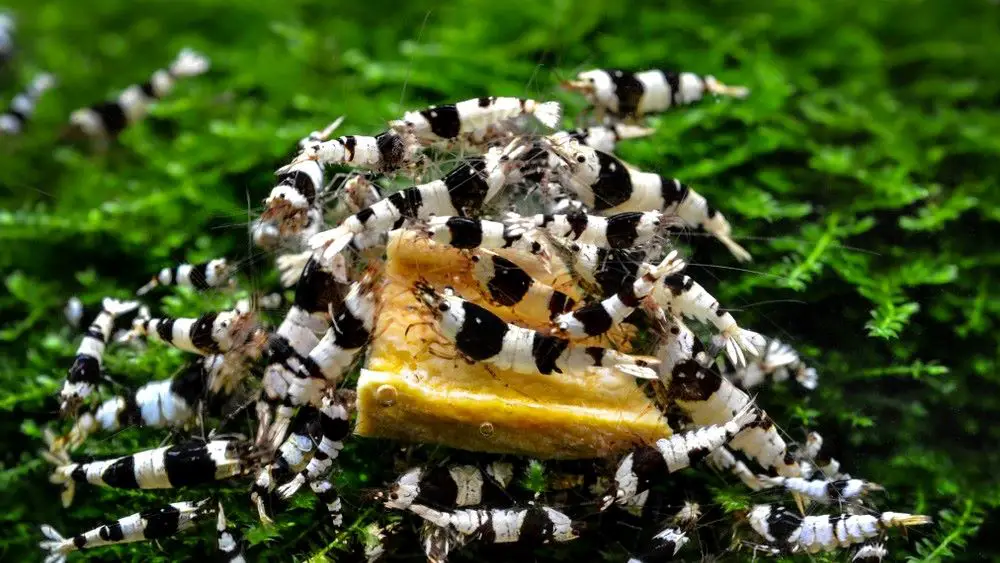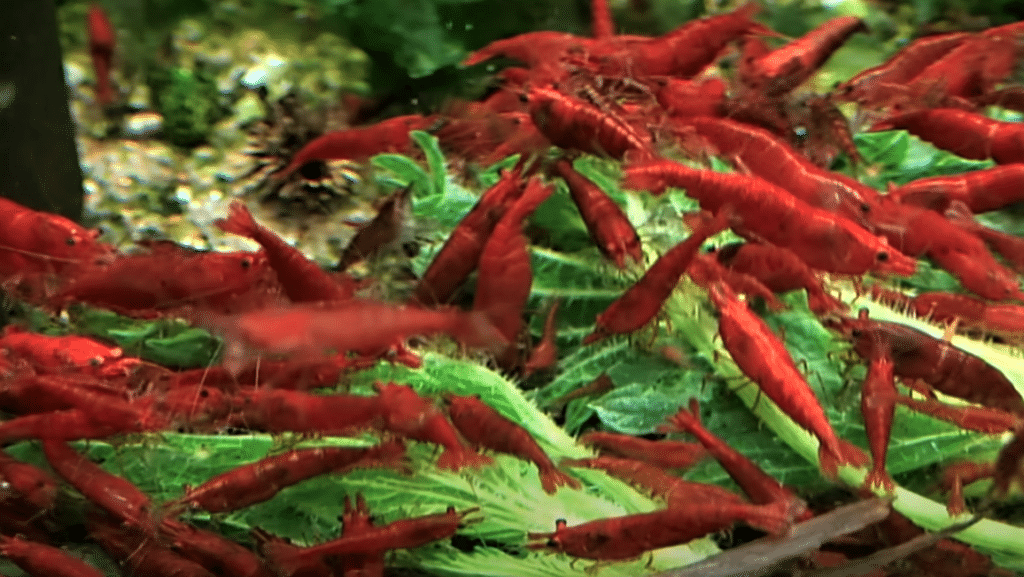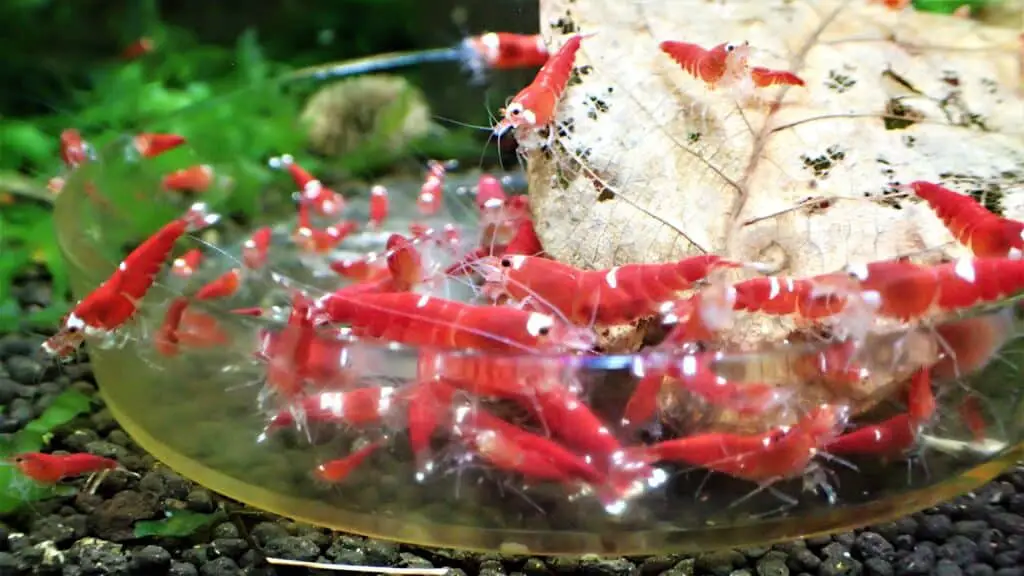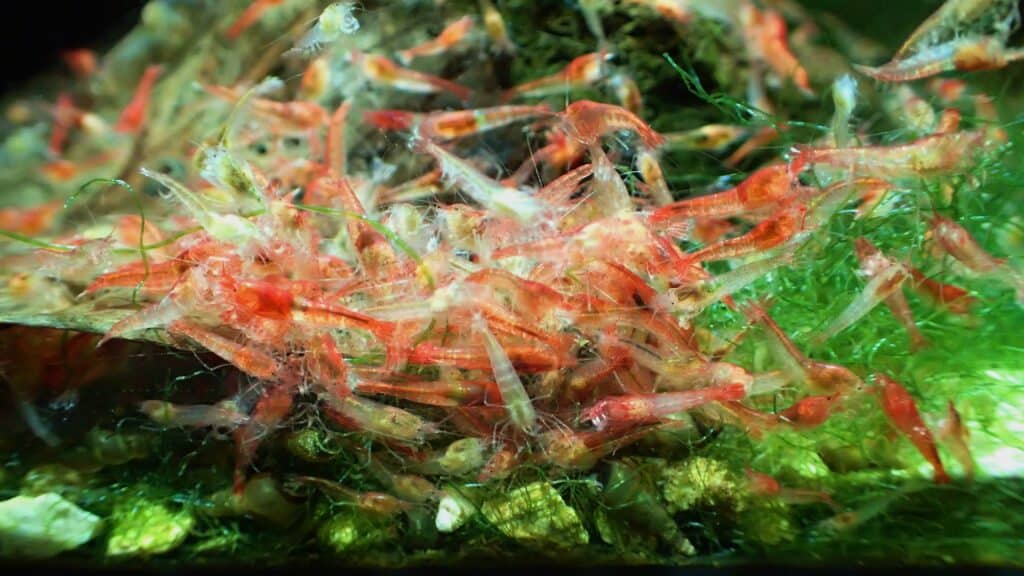Ever found yourself gazing at your thriving shrimp tank, a sense of pride washing over you as you marvel at the sheer number of shrimplets darting around? But then, a nagging question creeps in: Can you have too many shrimp?
Yes, it is possible to have too many shrimp in a tank. Overpopulation can lead to various issues, including stunted growth in young shrimp and potential tank failure if not adequately managed.
Hello, shrimpfam! Let me take you back to a time when I was just like you, a shrimp keeper with a tank teeming with life, a veritable underwater metropolis of shrimp. It was a sight to behold, but it wasn’t long before I noticed something was off.
The young shrimp seemed to be stuck in a perpetual state of adolescence, never quite reaching their full potential. The once spacious tank started to feel crowded, and I couldn’t help but wonder if I was doing something wrong. Was I overfeeding? Was the tank too small? Or could it be that I had too many shrimp?
Over the years, I’ve learned that shrimp keeping is a delicate balancing act. Too few shrimp and your tank feels empty, too many and you risk stunting their growth or worse, causing a tank failure.
In this post, I’ll share my experiences and the lessons I’ve learned about managing shrimp populations in a tank. So buckle up, shrimplets, we’re about to dive deep into the world of shrimp keeping!

What happens when a shrimp tank is overpopulated?
Overpopulation in a shrimp tank can lead to a cascade of issues that can disrupt the delicate ecosystem within. When the shrimp population exceeds the tank’s carrying capacity, the first thing you might notice is a change in the behavior and growth of the shrimp.
Young shrimp, in particular, may exhibit stunted growth. This is because the competition for resources, such as food and space, becomes intense in an overpopulated tank. The young ones, being smaller and less aggressive, often lose out, resulting in slower growth rates.
Overpopulation also puts a strain on the tank’s filtration system. Shrimp, like any other aquatic creatures, produce waste. In a balanced tank, the waste is broken down by beneficial bacteria and used by plants as nutrients. However, when the population is too high, the waste production can exceed the rate at which it’s broken down, leading to a buildup of harmful substances like ammonia and nitrites.
This can cause a decline in water quality, which in turn can stress the shrimp and make them more susceptible to diseases. In severe cases, it can even lead to a phenomenon known as ‘tank crash,’ where the sudden spike in toxins causes a mass die-off of the tank inhabitants.
While a bustling shrimp tank can be a joy to behold, it’s crucial to keep the population in check to ensure the health and wellbeing of your shrimp and the overall stability of the tank ecosystem.

How does overpopulation affect the growth of young shrimp?
When a shrimp tank becomes overpopulated, the growth of young shrimp, or shrimplets, can be significantly affected. This is largely due to the increased competition for resources in the tank.
In an overpopulated tank, food becomes a scarce commodity. Shrimplets, being smaller and less aggressive than their adult counterparts, often struggle to get their fair share. This lack of nutrition can lead to slower growth rates, as the shrimplets are not getting the nutrients they need to grow and develop properly.
Space is another critical resource that becomes limited in an overpopulated tank. Shrimp, like many other creatures, need a certain amount of space to grow and thrive. In a crowded tank, shrimplets may not have enough room to molt properly, which is a crucial part of their growth process.
This can lead to molting issues, which can further stunt their growth and even lead to health problems.
Moreover, the stress of living in an overcrowded environment can also impact the growth of young shrimp. High stress levels can suppress their immune system, making them more susceptible to diseases. It can also affect their behavior, making them less active and less likely to feed, further impacting their growth.
Overpopulation creates a challenging environment for young shrimp, where they struggle to access the resources they need to grow. This can result in stunted growth, health issues, and a lower survival rate among the shrimplets.
Therefore, maintaining a balanced shrimp population is crucial for young shrimp’s healthy growth and development.

What are the signs of overpopulation in a shrimp tank?
Recognizing the signs of overpopulation in a shrimp tank is crucial for maintaining a healthy environment for your shrimp. One of the first signs you might notice is a change in the behavior of your shrimp. They may become less active, more time hiding, or show signs of stress such as erratic swimming patterns.
Another sign of overpopulation is a noticeable decrease in the growth rate of young shrimp. If you observe that your shrimplets are not growing at the expected rate, or if they appear smaller than they should be at their age, it could be a sign that your tank is overpopulated.
Changes in water quality can also indicate overpopulation. If you’re performing regular water changes and maintenance but still noticing a consistent increase in ammonia, nitrite, or nitrate levels, it could be a sign that your shrimp are producing waste faster than it can be broken down. This is often a result of too many shrimp in the tank.
Lastly, an increase in disease or death among your shrimp can be a sign of overpopulation. In an overcrowded tank, disease can spread more quickly, and the stress of living in such conditions can make shrimp more susceptible to illness.
If you’re noticing a higher than normal disease or death rate in your tank, it’s worth considering whether overpopulation might be the cause.
Changes in shrimp behavior, slowed growth of young shrimp, deteriorating water quality, and increased disease or death are all signs that your shrimp tank may be overpopulated. Recognizing these signs early can help you take action to restore balance and ensure the health of your shrimp.

How can one manage the shrimp population in a tank?
Managing the population of shrimp in a tank is a delicate task that requires a balance of several factors. The first step is to understand the carrying capacity of your tank.
This is the maximum number of shrimp that your tank can support without negatively impacting the water quality or the health of the shrimp. Factors such as tank size, filtration capacity, and availability of hiding spots and food resources all contribute to determining this number.
Once you know your tank’s carrying capacity, it’s essential to monitor your shrimp population and ensure it stays within this limit. If you notice your shrimp population is growing too large, there are several strategies you can employ to manage it.
One method is to reduce the amount of food you’re providing. Overfeeding can lead to rapid population growth, increasing shrimplets’ survival rate. By reducing the amount of food, you can slow down the population growth. However, it’s important to ensure that your shrimp are still getting enough nutrition to stay healthy.
If your tank is already overpopulated, you may need to consider rehoming some of your shrimp. Many local fish stores or fellow shrimp keepers would be happy to take in healthy shrimp.
Lastly, regular monitoring and maintenance of your tank are crucial. Regular water tests can help you keep an eye on the water quality, while observing your shrimp can give you insights into their health and behavior. By staying vigilant and proactive, you can ensure that your shrimp population stays balanced and your tank remains a healthy environment for your shrimp to thrive.

In a Nutshell: Managing Shrimp Population in Your Tank
Overpopulation in a shrimp tank can lead to a host of issues, from stunted growth in young shrimp to a decline in water quality and even potential tank failure. It’s crucial to recognize the signs of overpopulation early, such as changes in shrimp behavior, slowed growth of shrimplets, deteriorating water quality, and increased disease or death.
Managing the shrimp population effectively involves understanding your tank’s carrying capacity, monitoring the population, adjusting feeding practices, and possibly introducing natural predators or rehoming some shrimp. Regularly monitoring and maintaining your tank are key to maintaining a healthy balance.
Remember, shrimp keeping is a journey, and every tank is unique. Don’t be disheartened if you face challenges along the way. Reach out for help when you need it. If you can’t reach me here, check out the Aquarium Shrimp Keeping community on Facebook. We’re all in this together, learning and growing as we navigate the fascinating world of shrimp keeping.
On a final note, always remember the joy and wonder that shrimp keeping brings. It’s not just about maintaining a tank, but about creating a thriving ecosystem that you can be proud of. So, keep going, keep learning, and most importantly, keep enjoying the journey. Happy Shrimp Keeping, shrimpfam!
FAQ: Managing Shrimp Population in a Tank
Q. Is there a limit to how many shrimp you can put in an aquarium?
A. Yes, there is a limit to how many shrimp you can put in an aquarium. This limit, known as the tank’s carrying capacity, depends on factors such as tank size, filtration capacity, and availability of food and hiding spots.
Q. What happens if you exceed the limit of shrimp in a tank?
A. If you exceed the limit of shrimp in a tank, it can lead to overpopulation issues. These can include stunted growth in young shrimp, a decline in water quality due to excessive waste, and increased disease or death among the shrimp.
Q. How can I control the population of cherry shrimp in my tank?
A. You can control the population of cherry shrimp in your tank by monitoring their numbers, adjusting feeding practices, introducing natural predators, or rehoming some shrimp if necessary.
Q. How many shrimp per gallon of water is considered healthy?
A. The general rule of thumb is to have 2-5 shrimp per gallon of water. However, this can vary depending on the specific conditions and setup of your tank.
Q. Can overpopulation affect the health of my shrimp?
A. Yes, overpopulation can negatively affect the health of your shrimp. It can lead to increased competition for resources, stress, disease, and even mass die-offs in severe cases.
